Donna Uchizono premieres a new work at Gibney Dance’s Agnes Varis Performance Center.
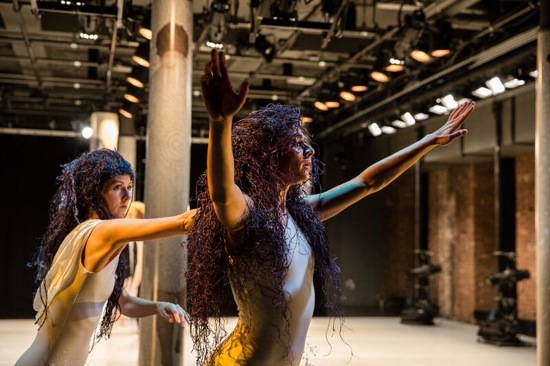
Heather Olson (L) and Molly Lieber in Donna Uchizono’s Sticky Majesty. Photo: Scott Shaw
“Donna Uchizono: Woman of Mystery.” Does that sound about right? No, it’s too much of a cliché to apply to a choreographer whose next step you can never anticipate and whose every new work adjusts your perceptions. Her 1995 Drinking Ivy, for instance, began with Levi Gonzalez standing alone at the rear of the stage—his back to the audience and his knees slightly bent—for close to two minutes; even after the other two performers entered, he didn’t move until almost the eight-minute mark. Uchizono’s 2006 Leap to Tall (a Bard Summerspace commission) was a trio for Jodi Melnick, Hristoula Harakis, and Mikhail Baryshnikov. I’m therefore not surprised when she cordially greets the spectators entering the smallish studio theater at Gibney Dance’s Agnes Varis Performance Center wearing a short, featureless orange dress, a spiky, patently unrealistic red wig, and what look like orange terrycloth clogs.
For Uchizono’s Sticky Majesty, two seating areas have been set at a right angle to each other. One displays white flooring, the other reveals its dark wood. I’m ushered to the white, or “desert” (?) part. The columns that stud the performing area have been wrapped in white paper bearing photographic images of a woman’s leg or arms or (this design, by Michael Grimaldi, helps make the column that’s not real match the others). Our side of the space has more depth; the other side is more of a ribbon.
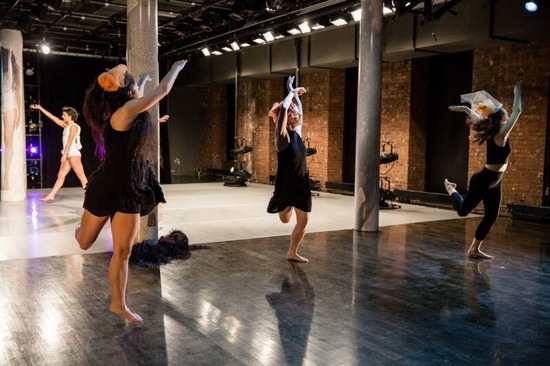
(L to R): Sarah Iguchi, Meg Weeks, and Hadar Ahuvia. At back: Molly Lieber. Photo: Scott Shaw
Sticky Majesty challenges our perceptions in more ways than one. For some spectators, the columns intervene. People seated in the “desert” have to turn their heads to see into the other space, while those sitting there can stare straight ahead and see, layered, all that’s happening. Both worlds, for all their clarity, are strange indeed. While David Shively’s fine score for trombone, cornet, cimbaloms, organs, percussion, and feedback instruments begins with a soft, pulsing drone, we watch three women dance in the white portion of the studio. Meg Weeks, Sarah Iguchi, and Hadar Ahuvia wear black dresses; short, bunchy gold net veils puff out around their faces much of the time. Heather Olson, confronting the spectators in the other part of the space is garbed in a white leotard; on her head is a purplish wig that looks as if it were made of raffia.
Throughout Sticky Majesty’s 90 minutes, the dancers in one area often pause so we can focus on the action in the other part of the room, or become so vehemently repetitious that we can put one image on hold while we check out the other area. A striking passage appears very early in the piece. Molly Lieber (white leotard, purple wig) enters from our left and travels in a V-shaped path past the women in black to join Olson. Her slow progress is arresting: she steps out into a lunge, then rises while bringing her back leg through until it is a waist-high pointer indicating her path. Can she hold it each time? Does she quiver? Barely.
Some “rules” gradually sneak into your mind. When in the wood-floored zone, dancers can touch each other and hook onto or lift each other in curious and complex ways. Lieber and Olson at times appear to be wrangling, so adversarial are their stances and so precarious their engagements. Yet they are clearly making something together.
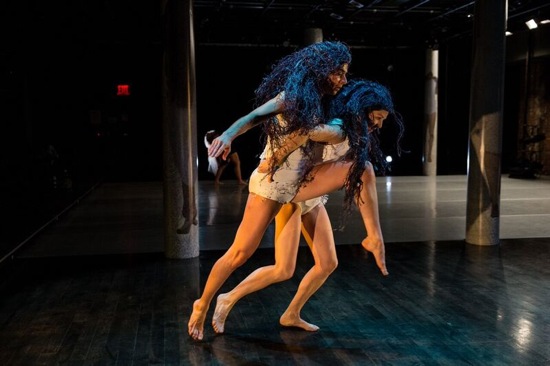
Heather Olson (R) lugs Molly Lieber in Donna Uchizono’s Sticky Majesty. Photo: Scott Shaw
It has apparently been decreed that Weeks, Iguchi, and Ahuvia will not touch their heels to the ground. They progress calmly toward and away from us with small steps —sometimes as tiny as ballet’s bourrées—as if they were wearing invisible high-heeled shoes. You begin think they could be digging grooves in the floor. This walk is their theme, and there are variants. Maybe they claw a hand as if holding a tool (or a scepter?), maybe they patter the back of one hand against the palm of the other, maybe they make a fist or stretch out one arm. Iguchi turns to face away from the audience, and at one point arches far back. Another time, their footwork approaches miniature Irish step-dancing. Weeks’s forward walk is brought up short by the fake pillar. She doesn’t try to go around it, just keeps her feet walking in place and lets the others pass her. It occurs to me that walking on tiptoe for a long time is extremely arduous, and I’m not surprised to see these bridal women begin to drip beads of sweat.
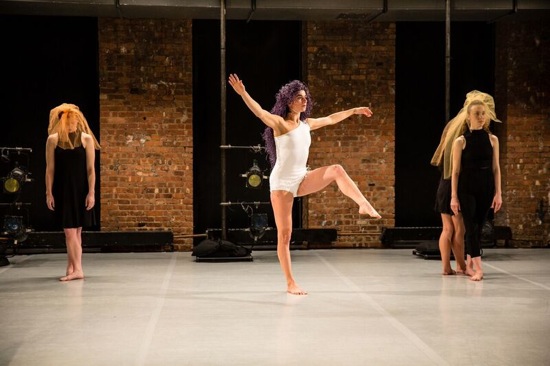
Molly Lieber crosses a foreign territory. (L to R): Meg Weeks, Hadar Ahuvia, and (hidden) Sarah Iguchi. Photo: Scott Shaw
The correspondences between the two factions are elusive. Every now and then a move created by, say, one of the two in white, is echoed later by one of three in black, as if a step or gesture has been projected into the ether and dust from it has fallen elsewhere. Lieber and Olson chase each other into foreign territory—Olson gradually weakening, Lieber insistently running in circles. And in one startling moment, after white and black have exchanged places, Iguchi crosses the boundary and Lieber coming unexpectedly face to face with her, swings one leg up and plants a foot squarely on Iguchi’s breastbone. The intruder is propelled back to where she came from, but there is no animosity; the women don’t even seem to see each other.
Once they change sides (also removing wigs and tying veils up), they change their behavior too. Ahuvia, Iguchi, and Weeks not only indulge in big, space-filling phrases of dancing, or ooze along the floor; they form peculiar, even riskily balanced tableaux. It’s as if they get stuck on one another temporarily, but they’re imperturbable; climbing and hanging off and lifting their colleagues are a way of life. Sometimes they make you think of inchworms, nuzzling their way toward the light.
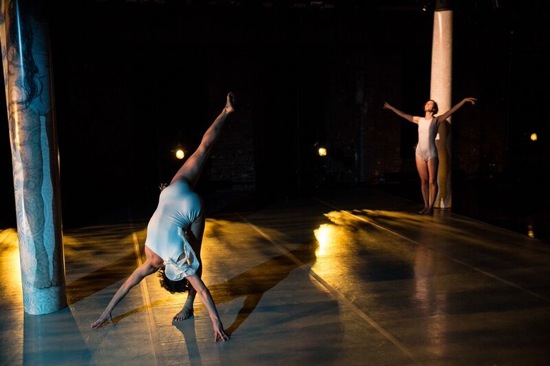
Molly Lieber (L) and Heather Olson in Sticky Majesty. Photo: Scott Shaw
Sometimes, too, you want to ask these valiant creatures, “what are you doing?” Many times Lieber, now in the “desert” moves to different places in the space by means of a seemingly inefficient strategy. She stands on one leg, lifts the other leg behind her, and tips far forward; then she lightly knocks her head against her ankle. She does this a number of times in different directions. Olson, meanwhile, stands against a pillar, arms spread, gaze up, as if receiving a vision.
What to make of these two? Side by side and close together, they walk toward us. Lieber’s head is so far back that you can admire the strong lines of her throat; Olson walks less assuredly, more prone to awkwardness, staring at us. Once, they seem to be compulsively grooming themselves, as if there’s a prescribed routine fot that. Once, they compulsively open their mouths wide and silently scream at each other.
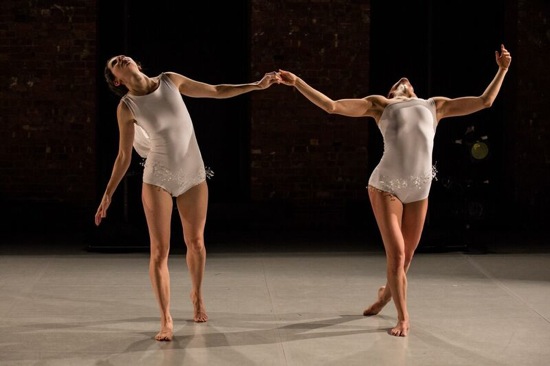
Heather Olson (L) and Molly Lieber. Photo: Scott Shaw
All along Shively’s music has ebbed into silence and risen into new and richly variegated storms of sound, or settled into rhythmic patterns. Natalie Robin’s lighting, clear and clean for the first half of the piece, turns dramatic for the second—changing colors, casting shadows, making beams slide across the floor.
Toward the end of Sticky Majesty, another hint as to the title appears. Lieber and Olson stop walking on their toes and laboriously twist and inch toward us, as if someone had spilled a little glue on the floor. A foot squeaks as it tries to slide forward, away from this arena and its enigmatic customs.
The work ends without fanfare. Just finishes with an exit and an almost exit and a blackout.
How is it that we can watch a ballet in which women dance on the tips of their toes by means of special shoes, wear fluffy little excuses for a skirt, and turn into swans and find nothing strange about it? (A fairytale to be sure, but that garb and those steps are carried into other less, mystical situations.) Yet when I watch Uchizono’s Sticky Majesty, I could believe myself to be not just a stranger in a divided world, but also in a double-faceted one. The dancers are themselves—accomplished individuals, whose breathing we hear and whose sweat we see. Lieber, a marvelous performer, also hints, with her gaze and her intensity, at something beyond the simple execution of the movement. But who are these personas and who/what do they represent? What causes them to act the way they do, to be so indomitable, yet so fragile, to manage feats of strength, yet wither inexplicably? Are they channeling other creatures, other societies, or only other states of mind?
Those enigmas, that strangeness, that fleeting beauty are there for us to fathom. But why try? They touch something within us the way fingers, not knowing the melody, probe a harp.

Fascinating review of what must have been a fascinating performance. I love “But why try? They touch something within us, the way fingers, not knowing the melody, probe a harp.”